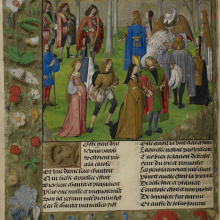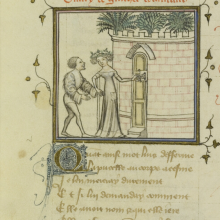St. Valentine's Day falls on February 14th and is called the holiday of lovers. Ewa Karolina Cichocka talks with prof. dr hab. Beata Możejko from the Faculty of History of UG about the roots and traditions of this holiday and the customs related to it that date back to the Middle Ages and even to antiquity.
- Professor, the celebration of Valentine's Day, and the associated amusements point to its American origin, a bit like Halloween. However, this tradition is much older and European.
- The popular belief is that the tradition of Valentine's Day dates back to the USA and the last hundred years and if you look deeper into the past, to the 17th century, England and Ireland. Meanwhile, this holiday of love and lovers has a much longer history, dating back to the Middle Ages and even to ancient times.
According to old accounts, the patron saint of the holiday celebrated on the 14th of February was and is (although it is rather forgotten nowadays) St. Valentine, a priest who died a martyr's death on this day in the 3rd century. He was condemned for helping couples who wanted to get married, while Emperor Claudius II ordered that men should serve in the army and not get married.
- Even the 'valentine' known today as a heart-shaped greeting card has a much longer lineage than we think. And is it true that there were two Valentines?
- According to a legend, before his death, Valentine was supposed to write 'Your Valentine' or 'From your Valentine' as a farewell letter to the girl who visited him in prison and lifted his spirits. Some even claimed that this letter was heart-shaped.
We still have the story of the second Valentine, who was a bishop and blessed the marriage of a Christian woman to a pagan. He died during the persecution of Christians, and years later a basilica was erected over his tomb, which contained a reliquary with the inscription 'Saint Valentine, patron saint of love'.
- You mentioned the ancient roots of the tradition, but here we have figures from Christianity. Was there anything else on this subject earlier?
- The date of Valentine's martyrdom coincided with the ancient tradition of celebrating Lupercalia on February 14 and 15, referring to the story of Romulus and Remus, who were saved by a she-wolf. Various gods were worshipped on that day, especially Faun, associated with fertility, fortune-telling and pair-bonding. So we have confusion, an overlapping of different traditions and stories.
- What traces can we find that testify to the popularity of the lovers' holiday centuries ago?
- The poet Geoffrey Chaucer (born ca. 1343, died 25 X 1400), author of, among others, the famous Canterbury Tales (the Silesian Library 2022 has just published its new translation by Jarek Zawadzki), contributed to the popularisation of St. Valentine's Day in medieval England.
Chaucer, in his poem The Parlement of Foules, mentioned that it is on St. Valentine's Day that birds meet to mate, the whole work refers to the mystery of love and was to be dedicated to the betrothal of King Richard II and Anne of Bohemia of the Luxembourg dynasty, daughter of Charles IV.
- And what was the situation on the other side of the English Channel?
- The festival of love was also very important at the court of France, King Charles VI (the Mad) and his wife Isabella of Bavaria. In January 1400, with the permission of Charles VI, but inspired by Duke Philip the Bold of Burgundy, the so-called 'Court of Love' was established. Louis d'Orléans and many other noble Lords, but also wealthy bourgeoisie and even the clergy.
And although no woman was officially part of this organisation, it was the praise of ladies that was the aim of the 'Court of Love'. Longing for spring, the French court celebrated courtship, i.e. poetic competitions devoted to love, in February, believing that nature was slowly beginning to revive.
On February 14th, St Valentine's Day, a dignified company of ladies and gentlemen would go to a holy mass, after which they would sit to judge and reward the best poems and gests.
The poet Christina de Pizan, associated with the aforementioned court, also played an important role in cultivating the festival of love, writing a piece about Louis d'Orléans' alleged appointment of the Order of the Rose for St Valentine's Day.
- Can we identify the oldest 'valentine' and its author?
- The oldest 'valentine' is believed to be a poem written by Prince Charles of Orléans (1394-1465) and dedicated to his wife Bona d'Armagnac. Charles was then in captivity with the English, captured in 1415 after the French lost the Battle of Azincourt. After more than 20 years, he returned to France and settled in the castle of Bolis, where he wrote more poems and ballads, including some dedicated to love.
Here is the first-ever valentine written by Charles d'Orleans (c. 1394-1465)
My Very Gentle Valentine
by Charles d'Orleans (c. 1394-1465)
loose translation/interpretation by Michael R. Burch
My very gentle Valentine,
Alas, for me you were born too soon,
As I was born too late for you!
May God forgive my jailer
Who has kept me from you this entire year.
I am sick without your love, my dear,
My very gentle Valentine.
- Thank you sincerely for the stanzas and the interview.
Illustrations :
- The God of Love - Amor locks the Lover's heart with a key, illustration for the 14th century manuscript of Romance of the Rose, National Library in Warsaw, free access: Polona https://polona.pl/item/le-roman-de-la-rose,MjAyODA1OA/45/#info:metadata
- Love invites you to dance in the garden, illustration from Romance of the Rose, Guillaume de Lorris; Jean de Meung, late 15th-century manuscript, the British Library, Harley MS 4425, public domain access.
- Miss Plocha introduces the Lover to the Garden, couple: https://polona.pl/item/le-roman-de-la-rose,MjAyODA1OA/18/#info:metadata, illustration for the 14th century manuscript of Romance of the Rose, National Library in Warsaw, free access: Polona


